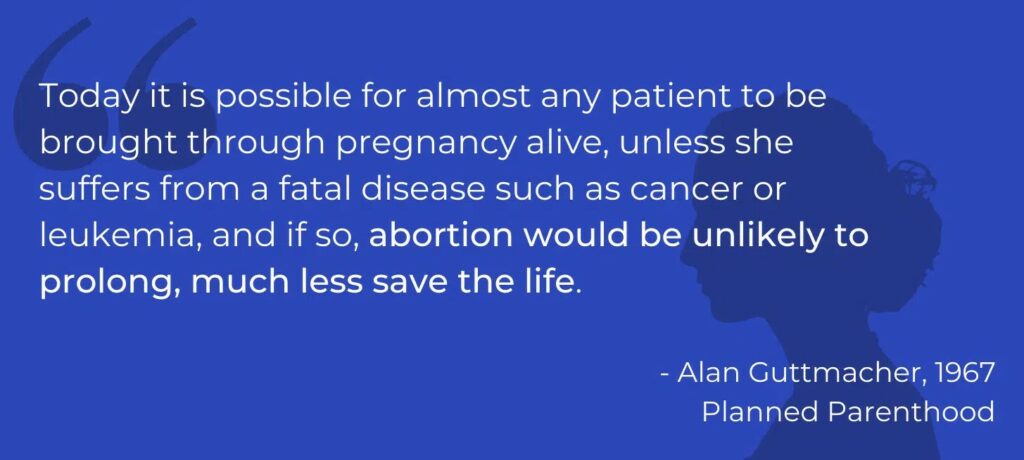
What Percentage of Abortions Are Medically Necessary?
By: Human Life International Staff, Updated February 15, 2024
How Common Are Life-Threatening Pregnancies?
Medical science has progressed to the point where an abortion is never necessary to preserve the life or the health of the mother. This has been true for more than half a century.
Abortions performed to preserve the life or the health of the mother are so rare that they do not register statistically, according to Alan Guttmacher of Planned Parenthood, who did more to promote and spread abortion on demand throughout the world than any other individual. In 1967 he commented, “Today it is possible for almost any patient to be brought through pregnancy alive, unless she suffers from a fatal disease such as cancer or leukemia, and if so, abortion would be unlikely to prolong, much less save the life.”1

In any case where both the mother and child are ill, both should be treated, and every effort should be made to save both mother and child. The American Association of Pro-Life Obstetricians and Gynecologists (AAPLOG) states that the term “abortion to save the life of the mother” is deliberately misleading terminology, and that no abortion saves the life of the mother; rather, doctors should treat both patients. For instance, prematurely delivering the baby may be an option if the mother is gravely ill, though AAPLOG acknowledges that in some cases, the baby may be too premature to survive.
Naturally, the percentage of abortions allegedly performed to save the life or health of the mother will vary somewhat based on country, but we can see from the testimony of doctors and researchers that these cases are exceedingly rare. Even abortionists testify that if there is a medical emergency, the course of action is to deliver the baby prematurely, because to go through the stages required by a surgical abortion (laminaria, stretching the cervix, etc.) would cause more, not less danger to the mother.
As far back as 1981, former Surgeon General of the United States Dr. C. Everett Koop said “The fact of the matter is that abortion as a necessity to save the life of the mother is so rare as to be nonexistent.”2 He was backed up by reformed abortionist Bernard Nathanson, who said not long after, “The situation where the mother’s life is at stake were she to continue a pregnancy is no longer a clinical reality. Given the state of modern medicine, we can now manage any pregnant woman with any medical affliction successfully, to the natural conclusion of the pregnancy: The birth of a healthy child.”3

In 1974, the “Father of Fetology,” Hymie Gordon, M.D., Director of Medical Genetics at the Mayo Clinic, stated, “In more than 25 years now of medical practice, I have come to learn that if a woman is healthy enough to become pregnant, she is healthy enough to complete the term ― in spite of heart disease, liver disease, almost any disease. As far as I’m concerned, there are no medical indications for terminating a pregnancy.”4
In 1981, Dr. Jasper Williams, Jr., of the Bernard Hospital in Chicago, Past President of the National Medical Association, said, “Since 1953, I have never seen a patient die because she needed an abortion and it could not be performed. Doctors now have the tools and the knowledge with which to work so that they can handle almost any disease a patient may have, whether that patient is pregnant or not, and without interrupting the pregnancy.”5
Data from six reporting states over the period of 24 years found that only 1.14% of abortions were performed for the mother’s life or physical health. Even the tiny percentage of 1.14% of abortions performed ostensibly for the women’s health are unnecessary, as there are alternative ways to save the mother without committing an abortion. This makes abortion obsolete, even in the most extreme circumstances.
There are several conditions that pose a threat to the mother’s physical and mental health which may arise during pregnancy. These are often presented as “necessitating” an abortion when they do not. As former abortionist Dr. Anthony Levatino has affirmed: “During my time at Albany Medical Center I managed hundreds of such cases by ‘terminating’ pregnancies to save mother’s lives. In all those cases, the number of unborn children that I had to deliberately kill was zero.” Dr. Levatino in these cases “terminated” the pregnancies he managed by delivering the babies early.
How to Handle Truly Life-Threatening Pregnancies
Again, abortion to save the mother should never happen. Therefore, in the increasingly rare cases where continuing the pregnancy causes real and immediate danger to the mother, the baby ought to be removed in such a way that every effort is made to preserve its life outside of the womb. In such a case, both mother and baby are treated because their lives are of equal value. If the baby should die after a premature delivery, the physicians have done all they could to save his or her life. They have not deliberately killed the baby.
“Preemie” survival rates are improving constantly. Even if a delivery occurred at a time when the baby was likely not viable, the fundamental difference is still the intent behind the act. It is never morally permissible to intend an evil outcome, and the death of an unborn child is most certainly an evil outcome (more explanation of these moral principles here). In the case of ectopic pregnancies, the mother may undergo an operation whose purpose is to save her life, even if the preborn child may die as an indirect result of the procedure.
What About Mental Health?
There is substantial evidence from several sources, including the Journal of Child Psychology and Psychiatry and BMC Medicine, that abortions do not solve mental issues, and usually aggravate them–even when compared to the mental health issues that sometimes develop from miscarriages. The research presented by the British Journal of Psychiatry concludes that long-term mental health problems in the wake of induced abortions increase, and the probability of depression, anxiety, guilt, and other mental sufferings goes up by 81% compared to mothers who carry their baby until birth. It is clear that abortion worsens mental health rather than relieving symptoms.

A handful of recent studies that allege that abortion is beneficial to the mental health of women invariably suffer from an extreme conflict of interest, since they are usually done by organizations that perform abortions themselves or aggressively advocate for them.6
“Medically Necessary” Abortions: A Legal Loophole
The term “medically necessary” is nothing more than a ruse used by the abortion industry to justify abortions of convenience.
As we explained above, AAPLOG has said that the term “medically necessary” is deliberately misleading. In fact, pro-abortion legislators use this vague term to enact laws that allow abortion on demand. Studies by the Guttmacher Institute (AGI), the world’s leading pro-abortion research organization, show that only from one percent to three percent of all abortions are performed for medical reasons, but well over 90% are performed for economic and social (“convenience”) reasons.7 One point that this study by the AGI demonstrates is that “medical necessity” is not even considered by the vast majority of mothers who intend to abort.
Although not the primary goal of the study, the data clearly shows that more developed countries have far fewer claims that abortion is medically necessary (20% claiming medical necessity as the main reason in Kenya, and in Finland only o.6%). In fact, in the United States, abortions are performed most often for reasons of convenience, such as finances or relationship status.
We frequently see examples of this abuse of terminology in the rationalizations offered by those arguing in favor of abortion. As the Catholic News Agency reports, Professor Lucia A. Silecchia of the Catholic University of America’s Columbus School of Law has pointed out that “there is no requirement for a doctor to even consider whether or not there exists an alternative to abortion that could solve the medical crisis.” The language of the legal statutes clearly has been twisted to make abortion freely available for any reason.
Using “medical necessity” as legislative terminology allows lawmakers to craft bills that have large loopholes defining what medical risk means. By tugging at our heartstrings with a purely emotional appeal, pro-abortionists argue that we cannot possibly refuse to “help” mothers. All over the world, pro-abortion organizations vastly inflate the numbers of abortions, create statistics on maternal mortality out of thin air, and use their invented numbers as a means towards abortion on demand.8 Dr. Bernard Nathanson, abortionist turned pro-lifer and co-founder of the National Abortion Rights Action League, has described this tactic in detail.

We should expect that this percentage of life-threatening pregnancies will only decrease as modern medicine continues to make progress in saving mothers from these tragic complications. We should, therefore, be progressing towards policies that treat both mother and child, as has always been the ideal. Namely, we must provide all ordinary means of keeping both the mother and the child alive, and the scope of these ordinary means expands as medicine progresses. The key to handling these situations is simply to acknowledge the humanity of both the mother and of the child.
Many public opinion polls show that a large majority of people do not want to pay for abortions, so pro-abortionists grossly overestimate the alleged “dangers” of pregnancy and childbirth in order to frighten people into supporting public abortion funding. Perpetuating the lie, they define a threat to the life of the mother in the same terms as a threat to her health. This way, abortion when the mother’s life is in danger leads to abortion for any reason at all:
- Abortionist Michael Burnhill of the National Abortion Federation (NAF) said that a “life of the mother” exception would allow him to perform all abortions he considered “medically necessary,” all those that would preserve a “condition in which one can actively participate in one’s total life.”9
- According to another author, “A Colorado abortion clinic director claimed that his extensive research showed that carrying a pregnancy to term is about 100 times more life threatening than having an abortion. He, therefore, considered any pregnancy life-threatening and used that as justification, certifying that the mother’s life was endangered.”10
- Abortionist Jane Hodgson testified under oath: “In my medical judgment, every pregnancy that is not wanted by the patient, I feel there is a medical indication to abort a pregnancy where it is not wanted. In good faith, I would recommend on a medical basis, you understand, that, and it would be 100.… I think they are all medically necessary.… I am considering the woman’s physical, mental, emotional and social and welfare and family and environment and all that.… I am concerned with the quality of life, not physical existence.”11
Hodgson also summarized the general pro-abortion attitude when she said, “A medically necessary abortion is any abortion a woman asks for.”12
In short, pro-abortion advocates can stretch exceptions allowing abortion when the mother’s life is in danger, making this exception cover abortion for any reason.
Conclusion
The percentage of abortions that are performed out of “medical necessity” is a dynamic statistic, but in the United States, cases of true medical necessity are exceedingly rare or nonexistent. They are in no way a justification for abortion.
The rare cases when the mother and child cannot both be saved should not be called medically necessary abortions, because effort is made to preserve both the lives of child and mother. In these instances, the only way to save the mother is by delivering, not killing, the baby.
This article was originally published in October, 2021 and was most recently updated in February, 2024
